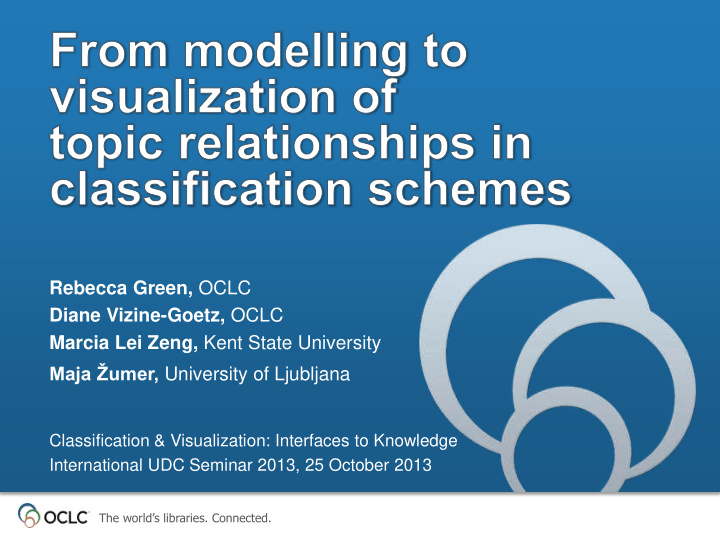



Rebecca Green, OCLC Diane Vizine-Goetz, OCLC Marcia Lei Zeng, Kent State University Maja Žumer, University of Ljubljana Classification & Visualization: Interfaces to Knowledge International UDC Seminar 2013, 25 October 2013 The world’s libraries. Connected.
Application of visualization techniques to DDC • Modelling topic relationships in the DDC • [Data format revision for topic relationships] • [Use scenarios] • Visualization of topic relationships in the DDC The world’s libraries. Connected.
DDC in FRSAD, so far • Each DDC class corresponds to a thema • Notation associated with the class is the nomen • Thema is the full category description of the class • Nomen is the symbol (or surrogate) used to represent the full category description: • dewey.info URI • hierarchically contextualized caption • Relative Index (RI) terms corresponding to functionally equivalent topics Data modeling – FRSAD – 1 The world’s libraries. Connected.
Extensions, set 1: All topics, Relative Index terms included • All topics are themas • All RI terms are nomens • Topics can be related to: • Classes (thema-to-thema relationship) • Other topics (thema-to-thema relationship) • RI terms (thema-to-nomen relationship) • RI terms can be related to each other (nomen-to- nomen relationship) Data modeling – FRSAD – 2 The world’s libraries. Connected.
Topic-enhanced view themas on left nomens on right only portions in solid lines now systematically captured in DDC database Data modeling – FRSAD – 3 The world’s libraries. Connected.
Extensions, set 2: Filling out the picture • Topic-to-class relationship attribute: equivalence status • Topic-reflecting text in class descriptions as parallel set of nomens (note: this is not a fully controlled vocabulary) • Nomen -to- nomen equivalence relationships • Between two synonymous RI terms • Between an RI term and textual expression Data modeling – FRSAD – 4 The world’s libraries. Connected.
Topics and their interrelationships (1) Data model, topic-to-topic The world’s libraries. Connected.
Topics and their interrelationships (2) Diabetes, comprehensive works Diabetes Diabetes insipidus mellitus Type 1 Type 2 Gestational diabetes diabetes diabetes Data model, topic-to-topic The world’s libraries. Connected.
Topics and their interrelationships (3) [Disciplinary contexts] Social Medicine, Cooking, services, 610 641.5 361-365 Adolescent Pediatrics Obstetrics Therapy medicine Diet therapy Data model, topic-to-topic The world’s libraries. Connected.
Relative Index (RI) terms and their interrelationships (1) Data model, RI-to-RI The world’s libraries. Connected.
Relative Index (RI) terms and their interrelationships (2) • Diabetes • Type 1 diabetes • Diabetes mellitus (Type 1) • Diabetes mellitus • Insulin-dependent diabetes • Type 2 diabetes • Gestational diabetes • Diabetes mellitus (Type 2) • Diabetes mellitus – • Non-insulin-dependent pregnancy complications – obstetrics diabetes • Noninsulin-dependent diabetes Data model, RI-to-RI The world’s libraries. Connected.
Notation for / Caption of Class (1) Core thema-nomen relationship The world’s libraries. Connected.
Notation for / Caption of Class (2) Notation Hierarchically-contextualized caption 362.196462 Social problems of and services to groups of people / People with physical illnesses / Medical services / Diabetes 616.462 Medicine / Specific diseases / Diseases of endocrine system / Diabetes mellitus 616.46206 . . . / Diabetes mellitus / Treatment 618.3646 Medicine / Gynecology and obstetrics / Diseases and complications of pregnancy / Diabetes 618.92462 Medicine / Pediatrics / Diabetes mellitus 641.56314 Cooking for people with medical conditions / People with diabetes Core thema-nomen relationship The world’s libraries. Connected.
Relative Index (RI) terms reflect Topics (1) Data model, topic-to-RI The world’s libraries. Connected.
Topics in Classes Data model, topic-in-class The world’s libraries. Connected.
Topic-in-class related to Topic-in-class (1) Data model, recursive topic-in-class The world’s libraries. Connected.
Topic-in-class related to Topic-in-class (2) • 616.462 *Diabetes mellitus Class here comprehensive works on diabetes Class diabetic nephropathies in 616.61 For diabetes insipidus, see 616.47 • 616.61 *Diseases of kidneys and ureters Class here diabetic nephropathies, nephrology Data model, recursive topic-in-class The world’s libraries. Connected.
Relative Index (RI) term leads to Class Data model, RI-to-class The world’s libraries. Connected.
Searching against authority Click on data . . . heading to access authority record Headings presented in context of classes / Related subheadings topics accessed through reference Subheading fields in can be record expanded / collapsed Visualization – class-and- The world’s libraries. Connected. subheading-based arrangement
Visual overview of diabetes across the DDC (1) Visualization – class-based The world’s libraries. Connected. arrangement – pyramid view
Visual overview of diabetes across the DDC (2) Visualization – class-based The world’s libraries. Connected. arrangement – pyramid view
Alternative view of diabetes across the DDC Visualization – class-based The world’s libraries. Connected. arrangement – matrix view (1)
Drilling down from 616.462 (1) Visualization – class-based The world’s libraries. Connected. arrangement – matrix view (2)
Drilling down from 616.462 (2) Visualization – class-based The world’s libraries. Connected. arrangement – matrix view (2)
Representative authority record LDR nz###n## 001 och 00127208 003 OCoLC- D 005 20110322091736.0 008 100206 |||a|z||||||##########||#a||#####d 040 ## $a OCoLC - D $b eng $c OCoLC - D $d OCoLC - D $f ddcri 083 04 $a 362.1964622 $ 0 (OCoLC-D)ocd00139591 $ 2 23 $ 5 OCoLC-D $ 9 as=AP $ 9 ps=PE $9 cts=2011-03-22T09:17:36Z- Rebecca Green 150 ## $a Type 1 diabetes 550 ## $w g $a Endocrine diseases $x humans $ 0 (OCoLC-D)och00043296 $ 2 23 $ 9 ra=AP $ 9 rv=PE $9 cts=2010-11-17T19:30:18Z- Joan Mitchell $9 uts=2011-03- 02T20:40:30Z- Rebecca Green 670 ## $a LCSH . $b Type 1 diabetes $ 0 (DLC)sh 85037456 $ 9 450 983 0 # $2 23 The world’s libraries. Connected.
Conclusion • Topics play key role in: • DDC data model • Uses of DDC, e.g., • End-user discovery • Editorial maintenance • Topic relationships are many + varied = complex • Visualization techniques address need to control topics to support use of DDC The world’s libraries. Connected.
Questions? The world’s libraries. Connected.
Recommend
More recommend